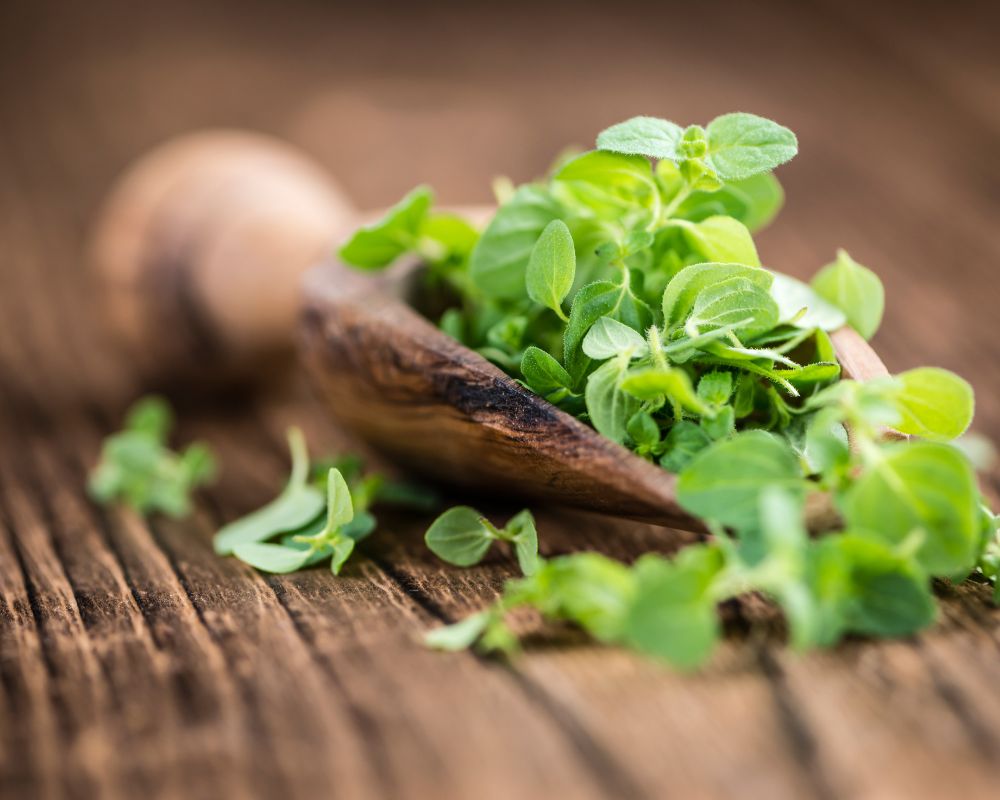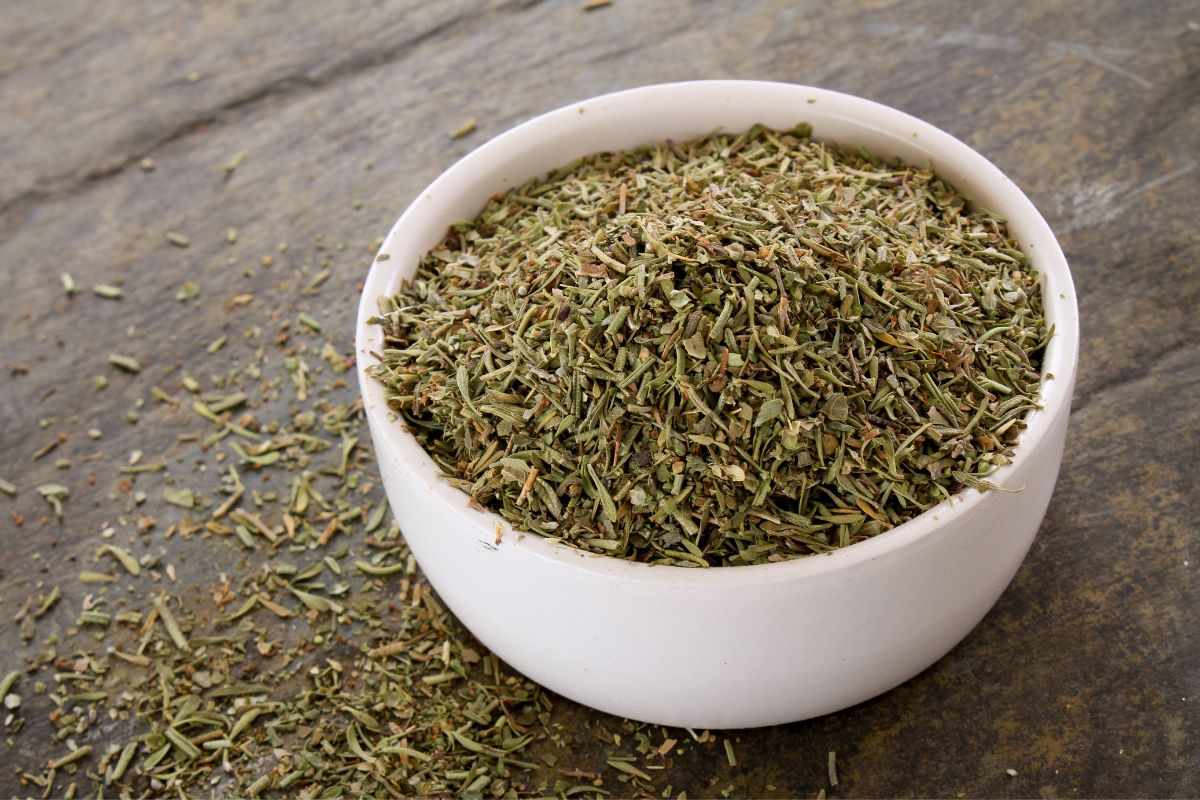Dried thyme is one of the most popular dried herbs worldwide. It has a herbaceous and earthy flavor profile — with hints of bitterness — that adds depth to recipes such as roasted meats, soups, and stews.
Table of Contents
What is dried thyme?

Dried thyme leaves are the dried leaves of the thyme plant (Thymus vulgaris). It belongs to the mint family Lamiaceae and is native to parts of Europe and Asia in the Mediterranean region. The plant also grows in Africa, the Caribbean, and the US.
While dried thyme is available as whole leaves, you can also find ground thyme in local stores and online. This powdered version of the dried leaves has notes of camphor and bitterness.
The flavor profile of dried thyme
Thyme leaves pack an earthy, woodsy, flowery, or minty flavor, depending on which variety you are using. For instance, common thyme, the most commonly used type, has a sharper taste. Meanwhile, lemon thyme delivers citrusy notes to recipes.
Thyme also has an herbaceous flavor and aroma. Dried thyme, in particular, has a more concentrated flavor profile. Apart from its earthy notes, you will also taste hints of bitterness.
This flavor profile pairs well with other popular herbs, including oregano, rosemary, and sage. With thyme’s versatility, you will often find it as part of a spice blend, za’atar, or bouquet garni, which people use to deepen the flavor of soups, stews, sauces, and marinades.
Nutritional benefits of dried thyme
Thyme is one of those herbs with culinary and medicinal purposes. Thymol, the main essential oil in the plant, has antimicrobial, anti-inflammatory, and antioxidant abilities. Thyme’s health benefits include lowering blood pressure levels, boosting immunity, and improving mood.
Many chefs crush dried thyme leaves before incorporating them into their recipes to help release the herb’s essential oils.
What is dried thyme good for?
Here are the best recipes that make good use of dried thyme.
- Pork Roast With Thyme: This savory recipe features roasted pork tenderloin topped with a mix of thyme and cider vinegar.
- Red Wine Beef Stew: Tender and mouthwatering, this recipe has the stew meat soaked in red wine, beef broth, and dried thyme.
- Chicken Thyme Soup: This comforting soup uses chicken stock and dried herbs such as thyme and bay leaves.
- Roasted New Potatoes With Thyme and Garlic: This tasty side dish highlights new potatoes roasted for about an hour and seasoned with dried thyme leaves, garlic, salt, pepper, and olive oil.
- Herb Bread: This bread loaf features an herb mix of dried thyme, parsley, oregano, and rosemary.
What is the difference between dried thyme and fresh thyme?

| Fresh thyme | Bright green to gray-green leaves |
| Dried thyme | Darker leaves, more potent flavor |
The small leaves of the thyme plant are available as fresh and dried. The color of fresh thyme ranges from bright green to gray-green, depending on the plant’s age. Their dried leaves are darker and more slender.
Generally speaking, dried herbs have a more potent and deeper flavor than fresh herbs. When using dried thyme as a substitute for fresh ones, you must follow a 1:⅓ ratio. You only need a teaspoon of dried thyme for every tablespoon of fresh thyme.
How do you use dried thyme?
Many people use thyme sparingly and early on to infuse the herb’s flavor into their recipes.
Some twine thyme sprigs and drop them into a soup or stew, only removing the bundle before they serve the dish. In some situations, people add the whole dried leaves. Some also prefer to use it crushed to help release healthy essential oils.
Where can you buy dried thyme?
You can buy dried herbs, typically contained in airtight spice jars, in a grocery store’s spice aisle. Many online shops also offer them. If you’re looking for an organic thyme leaf, you can find them at online and physical specialty spice stores.
Can you grow thyme?
This compact shrub is popular among home cooks and gardeners because you can easily grow and harvest thyme. You only need a warm, sunny spot in your garden and free-draining containers or garden soil.
How to dry thyme?
One of the best methods is air drying. Take small batches of the herb, tie the stalks, and hang them upside down in a well-ventilated and dark place for about two weeks.
You can also use a dehydrator:
- Gently swish thyme in a bowl of water.
- Drain the excess water and pat the stalks and leaves dry.
- Then lay them in a single layer and leave them in the machine for 2 to 5 hours at 105°F.
If you’re using an oven, lay the thyme on a baking tray lined with parchment paper. Set the oven to the lowest temperature. Drying time takes about 2 to 5 hours.
How to store dried thyme?
Once you’ve dried your thyme or obtained dried leaves from a grocery store, you should store them in an airtight container in a dry place away from heat and sunlight. Their shelf life is about 1 to 3 years.
What is the best dried thyme substitute?



If you need a dried thyme substitute, one of your first options is their fresh counterpart. For 1 teaspoon of dried thyme leaves, use 3 teaspoons or 1 tablespoon of fresh ones.
You can also use oregano as a swap (a 1:1 ratio). It’s also a member of the mint family, so it shares a similar minty and earthy flavor profile with thyme.
Marjoram, another member of the same botanical family, is also an ideal replacement, following a 1:1 substitution ratio. It carries a woodsy and piney flavor with bitter undertones.

